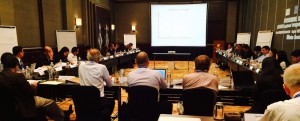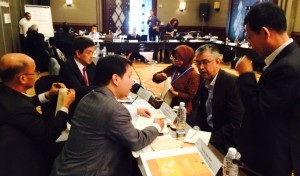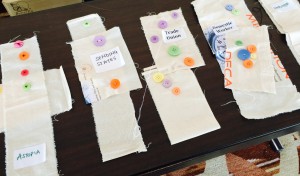 What can Oxford academics have to say to immigration policymakers from South East Asia? I always find it challenging speaking to practitioners, whether from the world of policy or advocacy and campaigning. They are experts with considerable experience whose legal knowledge and practical understanding is often unquestionably of greater reach than those coming to the field from an academic perspective. In this case, jointly delivering a course to ASEAN high level policymakers with the ILO (ASEAN regional integration: challenges and opportunities), the challenge is compounded by the fact that they are from a region in which I am interested but have very limited knowledge. Why would they want to hear from me?
What can Oxford academics have to say to immigration policymakers from South East Asia? I always find it challenging speaking to practitioners, whether from the world of policy or advocacy and campaigning. They are experts with considerable experience whose legal knowledge and practical understanding is often unquestionably of greater reach than those coming to the field from an academic perspective. In this case, jointly delivering a course to ASEAN high level policymakers with the ILO (ASEAN regional integration: challenges and opportunities), the challenge is compounded by the fact that they are from a region in which I am interested but have very limited knowledge. Why would they want to hear from me?
One reason we were invited to speak is that ASEAN (the ten states that comprise the Association of South East Asian Nations, Burma, Cambodia, Indonesia, Laos, Thailand, Singapore, Malaysia, Brunei, Philippines, Vietnam) is building towards regional economic integration. The Asian Economic Community (AEC) will be established in December 2015. This will facilitate free movement of goods, services, and skilled workers, and freer movement of capital with the aim of promoting regional integration and enhancing global competitiveness. Thus ASEAN policymakers are interested in learning about intra regional migration within the European Union.
Not an Asian EU
The AEC proposals are a very different model from the EU. There will not be AEC citizenship, and mobility will be restricted to skilled workers, in a context where labour markets are often (but not always) considerably less regulated. However, as in the EU there is often public hostility to migrants from poorer states, pressure from employers in some sectors to loosen border controls and irregular migration. In this respect the course was an interesting two way learning opportunity.
 But it wasn’t just a question of bringing a comparative perspective. For the participants it offered two days of going back to basics. Thinking about who counts as a ‘migrant’, what is ‘work’, and when is work in the labour market – all questions which turn out to be surprisingly contentious, but which pass unremarked when devising policy on ‘migrant workers’. Whose interests are prioritised in immigration policy making? And what are states trying to do with immigration policy – make distribution more equitable? Increase productivity? Preserve public order? What about internal contradictions and conflicts within states? Why is immigration policy so often the preserve of interior rather than labour ministries? These are important questions that the participants do not usually have the time nor the framework to consider, where academics have something to offer. The course offered an opportunity to step back from the day to day
But it wasn’t just a question of bringing a comparative perspective. For the participants it offered two days of going back to basics. Thinking about who counts as a ‘migrant’, what is ‘work’, and when is work in the labour market – all questions which turn out to be surprisingly contentious, but which pass unremarked when devising policy on ‘migrant workers’. Whose interests are prioritised in immigration policy making? And what are states trying to do with immigration policy – make distribution more equitable? Increase productivity? Preserve public order? What about internal contradictions and conflicts within states? Why is immigration policy so often the preserve of interior rather than labour ministries? These are important questions that the participants do not usually have the time nor the framework to consider, where academics have something to offer. The course offered an opportunity to step back from the day to day
Playing the part
 The session that I as a session leader found most enjoyable, was the one on domestic labour. For reasons of time it was the only session where it was possible to do group work. We held a role play, with a fictional state, Astopia, consulting various interest groups about whether they should open up a migration route for domestic work. It was striking how some participants were able to take on new roles very convincingly. One man, who was in fact a representative of Malaysian employers, was portraying a trade unionist and making an impassioned argument for a closed shop and compulsory trade union membership – the response to this suggestion from our ‘domestic workers’ was not positive. They had been advocating for the importance of joining a trade union, but now the complexion of Astopian trades unions was revealed they were having second thoughts. For participants it demonstrated the importance of consultation between trades unions and migrant workers if trades unions are to represent their interests. As well as developing a common position, each interest group was given an additional task. Domestic labour, we said, is all about multi-tasking, and it is often considered unskilled. This is certainly the case when it comes to immigrationpolicy. So we asked the policymakers to sew some buttons on to canvas while they were having their discussions, and to use their product when they gave evidence. In some groups the women participants showed the men what to do. The sending country representatives were extremely apologetic about the poor quality of their product. “You see, we are only bureaucrats. We sent all our domestic workers away, and now we do not have the talents we need to sew on buttons”. I don’t know if they will remember how demanding some apparently simple tasks are when they get home, but I hope so.
The session that I as a session leader found most enjoyable, was the one on domestic labour. For reasons of time it was the only session where it was possible to do group work. We held a role play, with a fictional state, Astopia, consulting various interest groups about whether they should open up a migration route for domestic work. It was striking how some participants were able to take on new roles very convincingly. One man, who was in fact a representative of Malaysian employers, was portraying a trade unionist and making an impassioned argument for a closed shop and compulsory trade union membership – the response to this suggestion from our ‘domestic workers’ was not positive. They had been advocating for the importance of joining a trade union, but now the complexion of Astopian trades unions was revealed they were having second thoughts. For participants it demonstrated the importance of consultation between trades unions and migrant workers if trades unions are to represent their interests. As well as developing a common position, each interest group was given an additional task. Domestic labour, we said, is all about multi-tasking, and it is often considered unskilled. This is certainly the case when it comes to immigrationpolicy. So we asked the policymakers to sew some buttons on to canvas while they were having their discussions, and to use their product when they gave evidence. In some groups the women participants showed the men what to do. The sending country representatives were extremely apologetic about the poor quality of their product. “You see, we are only bureaucrats. We sent all our domestic workers away, and now we do not have the talents we need to sew on buttons”. I don’t know if they will remember how demanding some apparently simple tasks are when they get home, but I hope so.